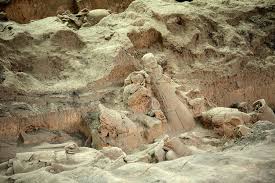
Were the Terracotta Army Buried Alive?
No, the Terracotta Army Were Not Buried Alive
The Terracotta Army is a collection of terracotta sculptures depicting the armies of Qin Shi Huang, the first emperor of China. They were buried with the emperor in 210–209 BCE to protect him in his afterlife.
Although the figures themselves are incredibly lifelike, they are not made from real people. Each warrior was individually crafted from clay, with unique facial features, hairstyles, and armor. The sheer scale of this project is astounding, with thousands of warriors, horses, and chariots created over several decades.
The Ancient Practice of Human Sacrifice
The belief that the Terracotta Army were buried alive likely stems from the fact that human sacrifice was practiced in ancient China, even during the Qin dynasty.
Before and during the Qin dynasty, it was not uncommon for rulers to be buried with their servants, concubines, and even officials, to serve them in the afterlife. This horrific act ensured that the deceased ruler would have companions and attendants in the next world. These individuals were indeed buried alive, a grim testament to the power of ancient beliefs and the absolute authority of the rulers.
The Terracotta Army: A Replacement for Human Sacrifice?
The creation of the Terracotta Army could be interpreted as a move away from the practice of human sacrifice. Instead of burying actual people with the emperor, Qin Shi Huang opted for a more "humane" approach by having clay replicas made.
These clay soldiers, while inanimate, would still serve their purpose of protecting the emperor in the afterlife, but without the loss of human life. This shift might signify a change in societal values or perhaps a pragmatic decision to preserve skilled workers and officials who could contribute to the empire's earthly prosperity.
FAQs
Were any actual people buried with Qin Shi Huang?
While the warriors were made of clay, it's believed that numerous workers who participated in the construction of the tomb complex were buried alive within it. This gruesome act aimed to keep the tomb's construction a secret and prevent the spread of information about its treasures.
Why did they bury the Terracotta Army?
The Terracotta Army was buried with Qin Shi Huang to protect him in the afterlife and serve him in the next world. This belief in an afterlife was prevalent in ancient Chinese culture, and elaborate tombs filled with precious items and sacrifices were created for emperors and high-ranking officials.
How many Terracotta Warriors are there?
It is estimated that there are over 8,000 soldiers, 130 chariots with 520 horses, and 150 cavalry horses, most of which remain buried in the pits surrounding the emperor's tomb.